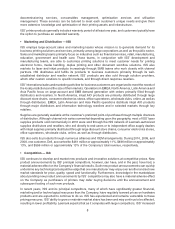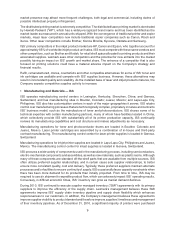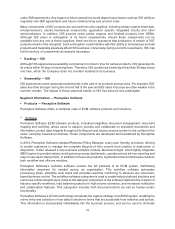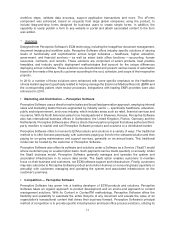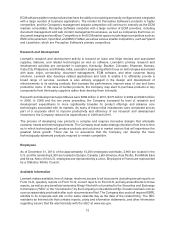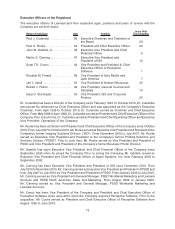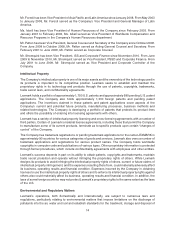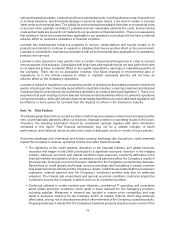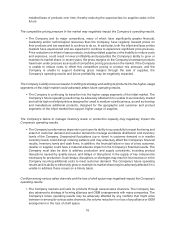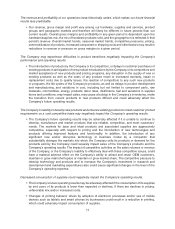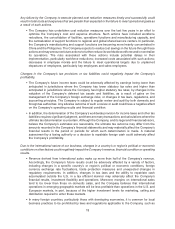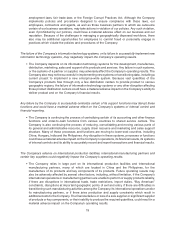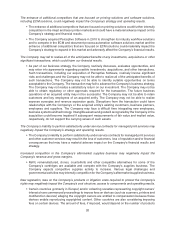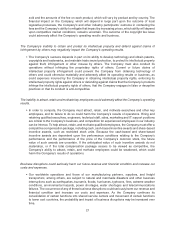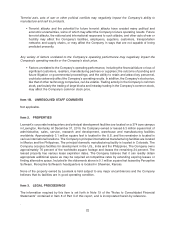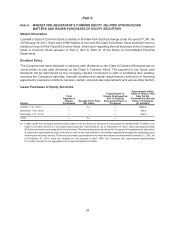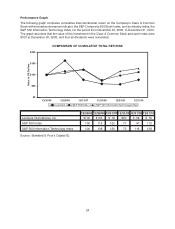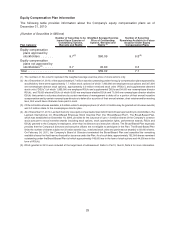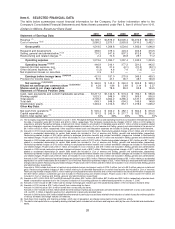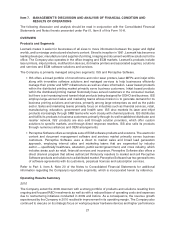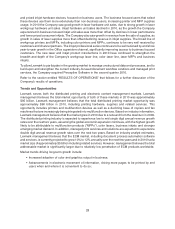Lexmark 2010 Annual Report Download - page 24
Download and view the complete annual report
Please find page 24 of the 2010 Lexmark annual report below. You can navigate through the pages in the report by either clicking on the pages listed below, or by using the keyword search tool below to find specific information within the annual report.Any failure by the Company to execute planned cost reduction measures timely and successfully could
result in total costs and expenses that are greater than expected or the failure to meet operational goals as
a result of such actions.
• The Company has undertaken cost reduction measures over the last few years in an effort to
optimize the Company’s cost and expense structure. Such actions have included workforce
reductions, the consolidation of facilities, operations functions and manufacturing capacity, and
the centralization of support functions to regional and global shared service centers. In particular,
the Company’s manufacturing and support functions are becoming more heavily concentrated in
China and the Philippines. The Company expects to realize cost savings in the future through these
actions and may announce future actions to further reduce its worldwide workforce and/or centralize
its operations. The risks associated with these actions include potential delays in their
implementation, particularly workforce reductions; increased costs associated with such actions;
decreases in employee morale and the failure to meet operational targets due to unplanned
departures of employees, particularly key employees and sales employees.
Changes in the Company’s tax provisions or tax liabilities could negatively impact the Company’s
profitability.
• The Company’s future income taxes could be adversely affected by earnings being lower than
anticipated in jurisdictions where the Company has lower statutory tax rates and higher than
anticipated in jurisdictions where the Company has higher statutory tax rates, by changes in the
valuation of the Company’s deferred tax assets and liabilities, as a result of gains on the
management of the Company’s foreign exchange risks, or changes in tax laws, regulations, and
accounting principles. The Company is subject to regular review and audit by both domestic and
foreign tax authorities. Any adverse outcome of such a review or audit could have a negative effect
on the Company’s operating results and financial condition.
• In addition, the determination of the Company’s worldwide provision for income taxes and other tax
liabilities requires significant judgment, and there are many transactions and calculations where the
ultimate tax determination is uncertain. Although the Company, and its legal and financial advisors,
believe the Company’s estimates are reasonable, the ultimate tax outcome may differ from the
amounts recorded in the Company’s financial statements and may materially affect the Company’s
financial results in the period or periods for which such determination is made. A material
assessment by a taxing authority or a decision to repatriate foreign cash could adversely affect
the Company’s profitability.
Due to the international nature of our business, changes in a country’s or region’s political or economic
conditions or other factors could negatively impact the Company’s revenue, financial condition or operating
results.
• Revenue derived from international sales make up more than half of the Company’s revenue.
Accordingly, the Company’s future results could be adversely affected by a variety of factors,
including changes in a specific country’s or region’s political or economic conditions, foreign
currency exchange rate fluctuations, trade protection measures and unexpected changes in
regulatory requirements. In addition, changes in tax laws and the ability to repatriate cash
accumulated outside the U.S. in a tax efficient manner may adversely affect the Company’s
financial results, investment flexibility and operations. Moreover, margins on international sales
tend to be lower than those on domestic sales, and the Company believes that international
operations in emerging geographic markets will be less profitable than operations in the U.S. and
European markets, in part, because of the higher investment levels for marketing, selling and
distribution required to enter these markets.
• In many foreign countries, particularly those with developing economies, it is common for local
business practices to be prohibited by laws and regulations applicable to the Company, such as
18


